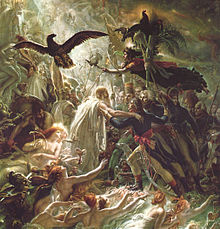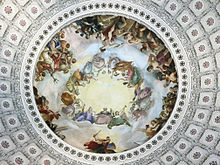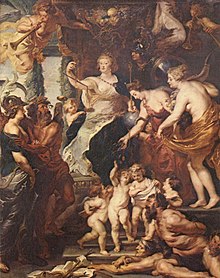apotheosis

Apotheosis ( ancient Greek ἀποθέωσις apothéōsis " deification ") originally referred to deification , that is, the elevation of a person to a god or demigod , but is also only used to describe a glorification or glorification .
Origin of the term
The idea of an apotheosis has its origins in Egyptian and Greek antiquity at a time when it was believed that “great personalities” would become gods and how they were worshiped. Behind the divinization during lifetime is also the thought that a living deity cares more about the well-being of a people or a community than a simple ruler. The protection of this deity is the stronger and greater, the sooner the ruler can refer to a divine descent (for example with Augustus as the great-nephew of Divus Iulius Gaius Julius Caesar ).
The apotheosis as a narrative topos
The apotheosis is a topos that is used to transfigure the end of a narrative. Even ancient Greek comedies end with an apotheosis, such as The Birds of Aristophanes .
In ballet and musical theater
Apotheosis has gained particular importance as a stylistic device in classical ballet, for example when the tragic death of a hero or the common death of a pair of lovers is exaggerated or glorified in the last scene (for example in Swan Lake ), or when the conflict on which the story is based a magical or mythical solution is applied (for example in Sylvia ). The corresponding number then also bears the designation "Apotheosis".
The apotheosis in the fine arts and in music
The apotheosis of eminent personalities is also a subject in the visual arts.
In music, the apotheosis is to be distinguished from the tombeau , a piece in the style of a deceased composer.
See also
literature
- Friedrich Hiller von Gaertringen : Apotheosis . In: Paulys Realencyclopadie der classischen Antiquity Science (RE). Volume II, 1, Stuttgart 1895, Col. 184-188.
- Arthur ER Boak : The Theoretical Basis of the Deification of Rulers in Antiquity. In: Classical Journal. 11, 1916, pp. 293-297.
- Franz Bömer: Ancestor cult and belief in ancient Rome. Leipzig 1943.
- Walter Burkert: Caesar and Romulus-Quirinus. In: Historia. 11, 1962, pp. 356-376.
- Jean-Claude Richard: Énée, Romulus, César et les funérailles impériales. In: Mélanges de l'École Française de Rome. 78, 1966, pp. 67-78.
- Bernadette Liou-Gille: Divinization des morts dans la Rome ancienne. In: Revue Belge de Philology. 71, 1993, pp. 107-115.
- David Engels: Postea dictus est inter deos receptus. Weather magic and regicide: On the background to the deification of early Roman kings. In: Gymnasium. 114, 2007, pp. 103-130.
- David Engels: Cum non comparuisset deorum in numero conlocatus putaretur. Rapture, Epiphany, and Consecration: Reflections on the Roman Emperor's Apotheosis. In: Dominik Groß, Jasmin Grande (ed.): The corpse object: mechanization, economization and staging of dead bodies. Campus-Verlag, Frankfurt am Main u. a. 2010, ISBN 978-3-593-39166-3 , pp. 79-133.
Web links
Individual evidence
- ↑ Matthew Naughtin: Ballet Music: A Handbook . Rowman & Littlefield, Lanham 2014, ISBN 978-0-8108-8659-9 , pp. 51 .

